The carbon footprint of beef
In 2008 the EPA began coming up with concrete solutions for reducing greenhouse gas emissions, and one of these solutions involved a tax on carbon emissions. When applied to ranchers, it meant they might have to pay an annual tax of approximately $98 for each cow they owned. Not surprisingly, beef producers were outraged, but environmentalists saw it as a reasonable action, given the carbon footprint of beef production. The tax wasn’t meant to penalize people for owning cows, but for the greenhouse gas emissions those cattle are responsible for emitting.(F2,F3,F4)
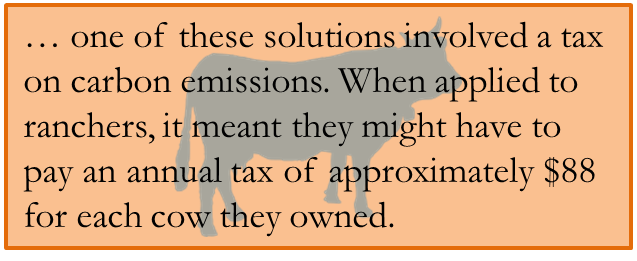
The idea of a carbon tax applied to agriculture is relatively simple. If beef production resulted in a certain amount of greenhouse gas emissions, and those emissions imposed a cost on the population today as well as future generations, beef producers should compensate society by paying a tax equal to those costs. This way, the animal would only be raised if society valued the food it produced more than the pollution it caused (that’s how the market works, it only sells things to consumers when the consumers are willing to pay more than what it costs to produce).
Of course, estimating the appropriate tax rate is difficult. It requires knowing (1) the amount of greenhouse gases emitted from each animal and (2) the damages those emissions impose on society. Estimating (2) is more guess-work than science, but measuring (1) can be done with scientific rigor. Scientists can measure greenhouse gas emissions from cattle by enclosing them in a container that traps all emissions from the cow while also bringing in fresh air for the cow to breathe. An example of such a contraption is shown below.(P3)
Figure 1—Device for measuring carbon emissions from cattle(P3)
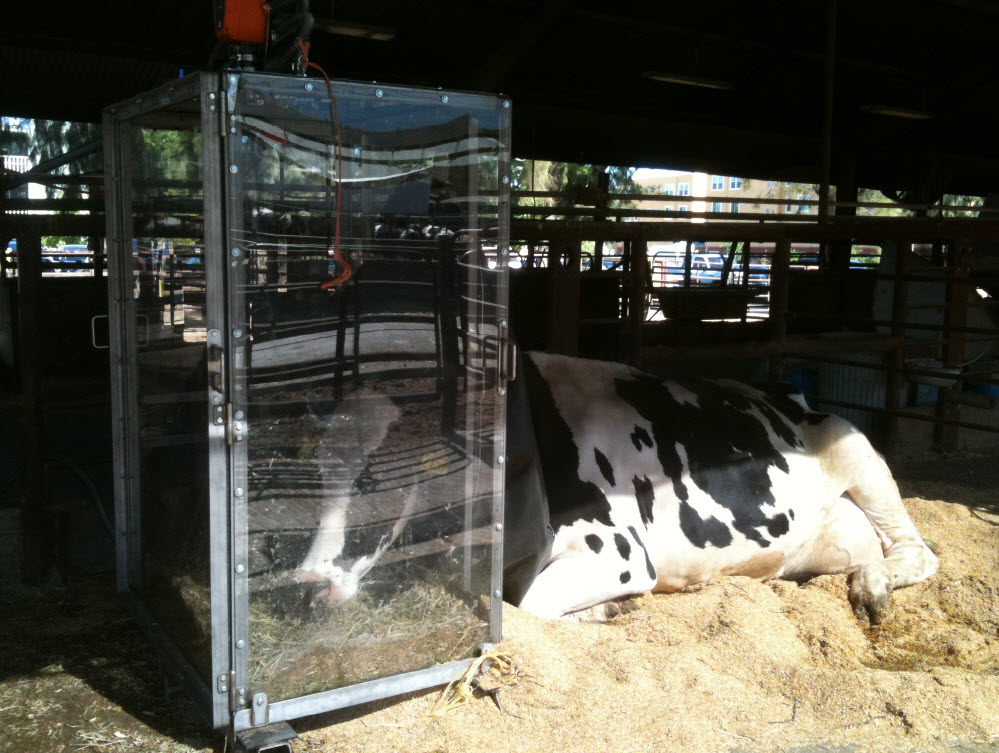
Of bovine and burps: what the environmentalists say
Beef is the signature American meat. When we think of grilling outdoors we think of hamburgers. The workingman’s quintessential lunch is a Big Mac combo meal at McDonald’s. The few times we go out for a special meal we are likely to order an expensive steak. Beef is there for us when we want a satisfying meal on a tight budget and when we spend liberally at a celebration. It is because of this that the true sacrifice of combating global warming became real when we were told [incorrectly] that beef is among the largest contributors to global warming, emitting even more greenhouse gases than the entire transportation sector. (Note that total greenhouse gases are usually measured in carbon-equivalent emissions, referred to as the carbon footprint. Methane results in 21 times the warming of CO2, so the carbon footprint of one ton of methane is typically reported as 21 tons of CO2. From now on, I refer to total greenhouse gas emissions in terms of its equivalent in carbon dioxide, which I refer to simply as “carbon”.)
But when it comes to bad for the environment, nothing—literally—compares with eating meat. The business of raising animals for food causes about 40 percent more global warming than all cars, trucks, and planes combined. If you care about the planet, it's actually better to eat a salad in a Hummer than a cheeseburger in a Prius.
—Bill Maher, host of HBO talk show Real Time with Bill Maher, writing in the Huffington Post in 2009. Accessed April 25, 2013 at http://www.huffingtonpost.com/bill-maher/new-rule-a-hole-in-one-sh_b_259281.html.
The problem is: the claim, at least applied to the U.S., is not true. The idea that food produced from livestock contributes more to global warming than the transportation sector came from a United Nations report titled, Livestock’s Long Shadow.(S3) As the report suggests, it was intended to highlight the large carbon footprint from livestock production, but a number of errors were made in their calculations. When animal scientists later corrected for these errors they found that the U.S. livestock industry is responsible for around 3% of total man-made carbon emissions in the U.S., compared to 26% for the transportation sector.(C1,E2,F1,P1) The United Nations soon admitted their mistake, but they still argue that the population should transition away from meat, dairy, and eggs and replace them with grain and vegetables.(S4) The idea has caught on, as the popularity of “Meatless Monday’s” has spread from Los Angeles school systems to the Norwegian military.
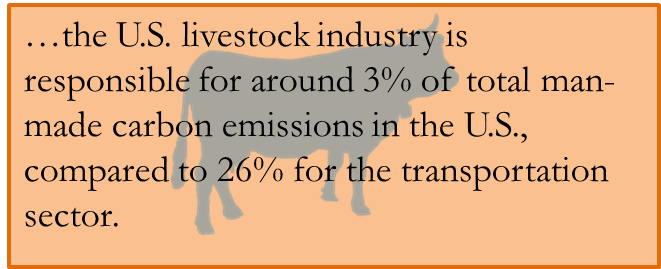
When dealing with issues as big as global warming ... it’s easy to feel helpless, like there’s little we can do to make a difference ... But the small changes we make every day can have a tremendous impact. That’s why this Meatless Monday resolution is important. Together we can better our health, the animals and the environment, one plate at a time.
—Los Angeles Councilmember Ed Reyes, co-author of a Meatless Monday resolution in 2012.(C2)
There is some justification for Meatless Mondays.(P2) Research comparing the typical meals of vegans and non-vegans in the UK found that the vegan diet results in a smaller carbon footprint.(B2) This study also found that vegans spent less money on food, and one must wonder how those savings were spent. If spent on an expensive flight for a vacation, the large emissions from the plane could offset the reductions from the vegan diet. However, if those savings are spent on the same basic goods and services as people spend the rest of their money on, this research suggests that vegan diets do indeed have a smaller carbon footprint.
Other research showed that vegan diets probably have a smaller carbon footprint than those including beef, but not necessarily those entailing chicken, pork, eggs, or dairy.(C1,V1,V2) Why single out beef? Beef is different because cows are ruminants, with a more complex food digestive system. Their stomachs contain four separate compartments. They “chew their cub”, which means they regurgitate some of the food they have swallowed, chew it some more, then swallow it again. Cows spend about one-third of their life chewing cud. Part of this digestive process involves burping—lots of it. Cows burp about once a minute, and as they do so they expel methane from their mouth—and a ton of methane creates 21 times the global warming as one ton of carbon dioxide.(F1,F2)
Indeed, the production of animal products, particularly red meat from ruminants, uses more energy and generates more [greenhouse gases] than does that of plant-based products.
—Vieux, Florent, Louis-Georges Soler, Djilali Touazi, and Nicole Darmon. 2013. “High nutritional quality is not associated with low greenhouse gas emissions in self-selected diets of French adults.” American Journal of Clinical Nutrition. 97:569-83.
Figure 2—Carbon footprint of selected food products(E3,V3,F4)
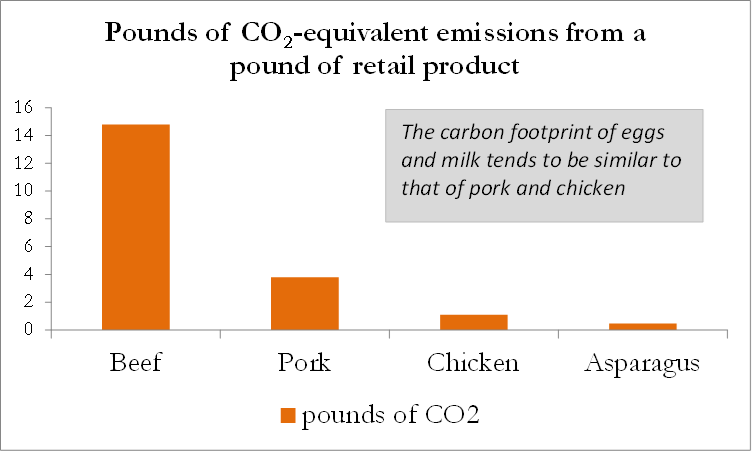
So beef is special in many ways. It is a luxury items on the menus of most fancy restaurants, has a starring role in America’s patented hamburger, and is a prime contributor to our carbon footprint.
The environmental movement has generally turned anti-cow, and the reason is given in Figure 2. This is the argument environmentalists use when they attempt to persuade us to eat less beef. Environmentalists are going to concentrate on the relative carbon footprint of beef relative to other foods, as well as the total carbon emitted by all beef cattle. They are unlikely to remark upon the reduction in beef’s carbon footprint over time, or the potential for even greater improvements—that banner will be lifted by the beef industry.
Austerity and efficiency
When responding to the environmentalists, beef producers tend to concentrate on the decrease in the carbon footprint of beef achieved in the last half-century, due to selective breeding and various production technologies like better feed, use of antibiotics, and growth hormones. What is so interesting about the carbon footprint debate is that both sides are correct. The environmentalists are right that beef does have a higher carbon footprint than most competing foods, and the beef industry is correct that it has reduced the carbon footprint of beef considerably. It was’t necessarily the intention of the beef industry to combat global warming, but they did so anyway in their constant pursuit of improved production efficiency. To understand the relationship between efficiency and carbon emissions, meet Gustavus Swift.
Gustavus Swift was no environmentalist. He was a producer of beef, connecting cattle production in the midwest with beef consumers living in the northeastern cities of the U.S., and he did so in the nineteenth century, when the environmental movement did not exist. Swift stayed busy pursuing profits, yet at the same time, this self-interested pursuit may have done more to benefit the environment than the average American today.
Although he sold beef on a massive scale he either broke-even or lost a little money from his beef sales. That was acceptable because he made his profits from the sale of beef by-products, like soap, leather, brushes, hair, and tennis racket strings. Every part of the cow that could possibly made into something was made into something, and Gustavus was so adept at profiting off the whole animal that very little of the carcass would be dumped in the rivers—and this was the nineteenth century, when Gustavus could have dumped anything he wanted into the river.
So efficient was Swift that he would wade out into the creek where a pipe from his slaughtering facility dumped whatever couldn’t be used into the creek, and he would stand and stare at the pipe, waiting to see what came out. If anything resembling animal fat, bone, or other by-products flowed out of the pipe he knew that something of value was being wasted, and he would track the source until he found the leakage and stop it. Although he did it to make money, it resulted in relatively little pollution entering the nearby creek and river.(H2)
Why tell this story? Because the story of how the self-interested pursuit of efficiency can be beneficial for the environment holds true in regards to livestock and global warming today. Chicken and pork are lower emitters of carbon than beef partly because they convert feed to lbs more efficiently. Likewise, the carbon footprint of beef is lower today than, say, fifty years ago because the beef industry has become more efficient. Between 1977 and 2007 the footprint of beef declined by more than 16%. How? By becoming more efficient, whereby ranchers today can produce the same amount of beef while using 19% less feed, 33% less land, 12% less water, and 9% less fossil fuel energy. Feed, water, and energy result in greenhouse gas emissions, so when there are fewer of these inputs needed to produce a lb of beef, the carbon footprint of that beef declines. (C4)
Figure 3—Efficiency can be environmentally-friendly
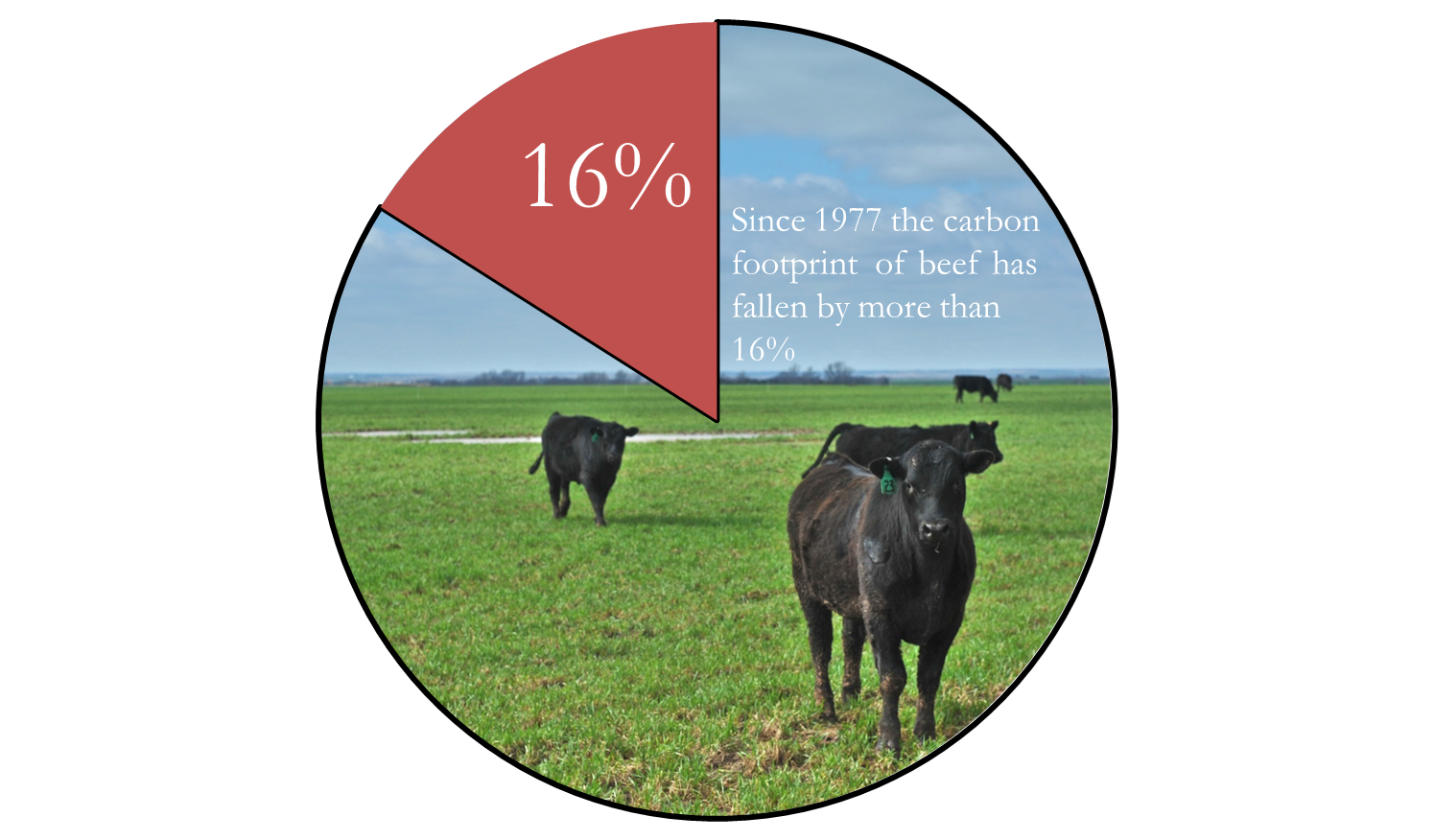
Some of this beef production takes place on land that could not be used to raise crops, so one cannot just assume that substituting, say, asparagus for beef, is an easy solution to global warming, as asparagus simply cannot be grown in most places where cattle are grazed. Indeed, because some land is only suitable for grazing, one study found a diet including a little meat may have a smaller footprint than a vegan diet.(L1)
As the beef industry focuses more on reducing carbon emissions we should expect the carbon footprint to fall even more. Technologies like growth hormones increase the conversion of feed into meat and thus reduces beef’s carbon footprint. By modifying cattle feed and selectively breeding for offspring who produce less methane, researchers believe they can likely achieve a 25% reduction in beef’s carbon footprints.(A2,E4) Of course, other livestock industries might reduce their footprint even more, so this optimistic projection doesn’t necessarily mean cattle will become as carbon-friendly as their non-ruminant counterparts (i.e., chicken and poultry).
Remember, though, the idea behind good environmental policy is not to ban certain foods, but to make the retail prices consumers pay reflect the true cost of the carbon emissions resulting from the product. It could very well be that beef is charged a higher carbon tax than other foods without decreasing beef consumption much, simply because consumers decide they would rather decrease consumption of other goods rather than their beloved beef.
In the end the tax may not even be all that much. Imagine all of your activities throughout the year that result in carbon. Almost everything you do creates carbon emissions, though some more than others. If these emissions make you feel guilty you can easily go to carbonfund.org and purchase something called an “individual annual offset: 24 tonnes”, priced at $240. You see, the average American causes about 24 tonnes of carbon emissions, but by spending only $240 your money is used to fund activities that reduce the world’s carbon emissions by 24 tonnes. So for only $240 a year you can make your entire life carbon-neutral. I don’t know about you, but that seems pretty cheap to me. And if livestock production creates only 3% of emissions in the U.S., the cow tax might not pose much of a burden.
Beef: the carbon-friendly meat?
While some environmentalists debase beef for its high carbon-footprint, others see it as a major weapon against rising global temperatures. The documentary Carbon Nation remarks how converting cropland that had been heavily plowed for years into perennial grasses results in carbon sequestation, where carbon is taken from the atmosphere and used to grow plant roots. So long as those roots stay in the soil, the carbon does as well. If vast stretches of such cropland were converted to grassland the documentary suggests that a remarkable amount of greenhouse gases might be removed from the atmosphere. Total carbon emissions for the U.S. might be reduced by 39%, the documentary claims.(B4,B5) Moreover, grazing cattle on the grass can help the grass grow. More cattle on more grasslands might then lower the carbon footprint of beef—perhaps by so much that grass-fed beef assimilates more greenhouse gases than it emits.
Beef would then become a carbon sink, not a carbon emitter.
The term “grass-fed” merits some explanation. As revealed in the virtual beef farm tour, most cattle do indeed graze grass for most of their life, but at the end of their life are “finished” on corn. Grass-fed beef is different in that forage (grass and hay) constitutes virtually all of their diet throughout their life.
For grass-fed beef to possess a lower carbon-footprint than regular beef, the cropland converted to grasses would have to store an enormous amount of carbon in the soil. The reason is that all other aspects grass-fed beef result in large emissions, as animal scientist Jude Capper explains.
[Grass-fed cattle] have a far lower efficiency ... The animals take 23 months to grow versus 15 [for corn-fed cattle]. That’s an extra eight months of feed, of water, land use obviously, and an awful lot of waste. If we have a grass-fed animal compared to a corn-fed animal, that’s like adding almost one car to the road for every single animal. That’s a huge increase in carbon footprint.
—Capper, Jude [interviewee]. May 6, 2011. “Why Grass-Fed Beef Is Worse for Environment.” Stossel [television show] Fox Business Video. Stossel, John [interviewer].
Figure 4—Grass- and corn-finished beef(C5)
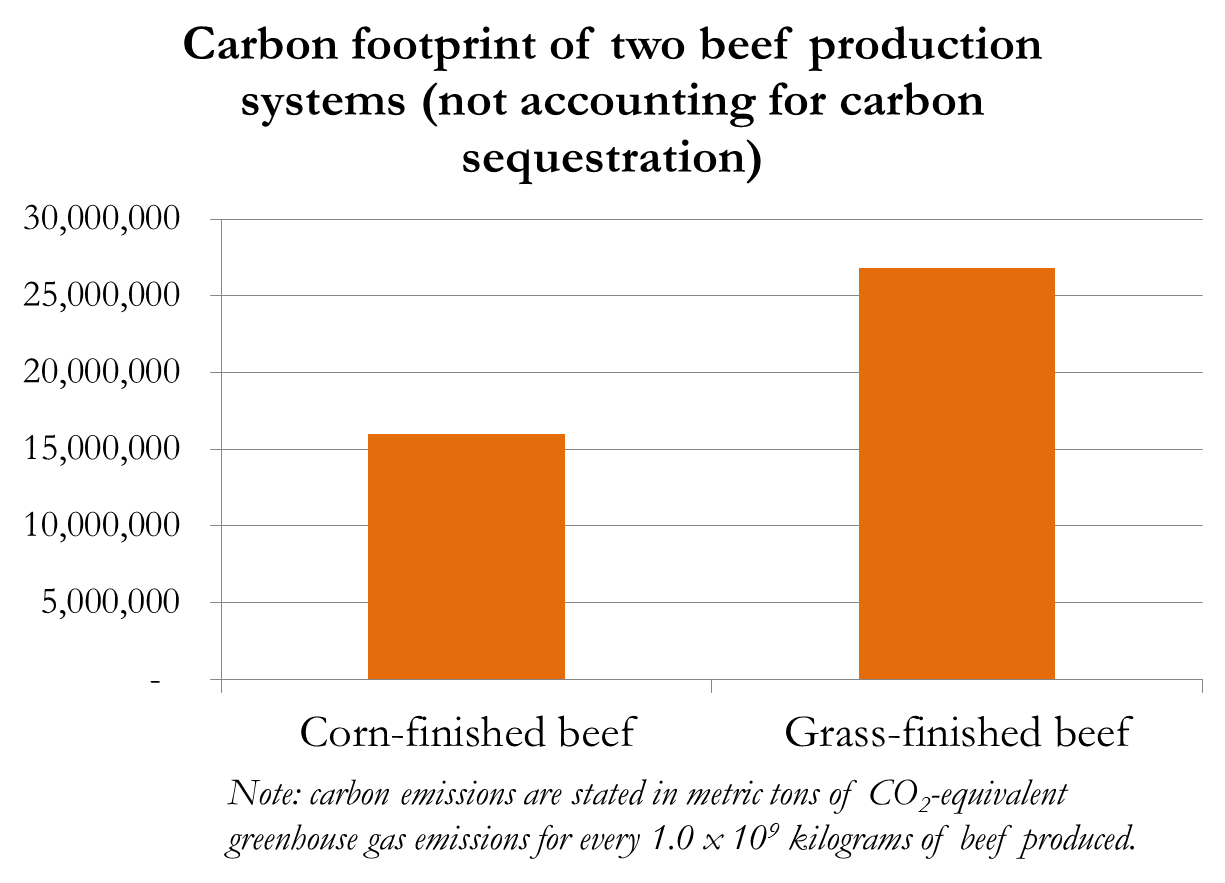
So grass-finished beef has the advantage of storing carbon in the soil, if the grass was established on recently converted cropland; but grass-finished beef has the disadvantage that it is less efficient, requiring more inputs to produce a single lb of beef, and more inputs means more carbon. All things considered, does grass-finished beef has a lower footprint? One of my graduate students is currently crunching these numbers, and it seems unlikely, though not impossible. It depends on the rate at which pasture can sequester carbon in the soil, and scientists are still trying to estimate these numbers. Also, sequestration of carbon in the soil only really takes place when heavily plowed land is converted to grassland. This sequestration happens slowly, over decades, and eventually reaches a point where no more carbon is sequestered. For this reason, grass-finished beef cannot be a permanent solution to global warming, though at this point environmentalists are just looking for anythingthat could reduce the rate of emissions—permanent or not.
Figures
(1) Made available from Dr. Sara Place, Department of Animal Science at Oklahoma State University, in 2014.
(2) Original figure.
(3) Original figure. Photo from the DASNR Kitchen Sink at Oklahoma State University.
(4) Original figure.